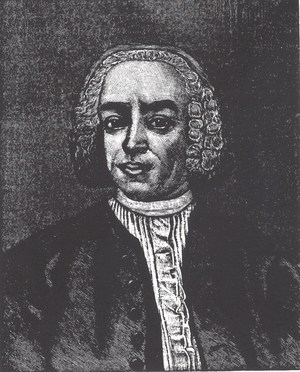Bodo Otto

Dr. Bodo Otto (1711–1787) was a Senior Surgeon of the Continental Army during the American Revolution. He was one of the early settlers of Philadelphia, Pennsylvania, having emigrating from the Electorate of Hanover in what is now Germany.Germany]] in 1755.[1]
During the Revolution the Second Continental Congress appointed Otto to establish a military hospital in Trenton, New Jersey for the treatment of smallpox. He was present during the Battle of Long Island in 1776.[2] He was also assigned to the Continental hospital at Valley Forge and located in the Uwchlan Meetinghouse.[3] Later during the Revolution, Otto was put in charge of the hospitals in Yellow Springs (in what is now Chester Springs, Pennsylvania), where he and his son treated the ill soldiers from Valley Forge.[1] IOn Christmas night of 1777,Dr. Otto and his son crossed the ice choked Delaware River with General Washington and his army and surprised British troops and Hessian mercenaries encamped at Trenton. He was widely respected for selflessly treating wounded and dying Hessians. There were only a smattering of casualties on the American side.
His three sons were also physicians for the Army, and assisted him as Junior Surgeon and Surgeon Mates.[1]
Otto did not retire from his Army service until the age of 70.[1]
Prior to the Revolution Otto publicly opposed the Stamp Act and also served on the Berks County Committee of Public Safety.[2]
Some of his medical training he received at the University of Göttingen.[4] Bodo used Trinity Lutheran Church in Reading as a hospital to treat wounded soldiers from the Battle of Brandywine.
Otto died in 1787 and was buried in Reading, Pennsylvania at the Trinity Lutheran Church (where he was a member) Cemetery.[5] Many of his surgical instruments as well as a portrait of him and his wife are in the collection of the Historical Society of Berks County in Reading.
A great grandson, William Todd Otto, a Judge from Indiana, served in Abraham Lincoln's cabinet as Assistant Secretary of the Interior. According to the New York Times, Judge Otto was one of twelve men permitted at Mr. Lincoln's bedside when he died.
See also
References
- 1 2 3 4 Otto
- 1 2 "Historical Markers". explorepahistory.com. Retrieved 3 October 2010.
- ↑ "National Historic Landmarks & National Register of Historic Places in Pennsylvania" (Searchable database). CRGIS: Cultural Resources Geographic Information System. Note: This includes David C. Stacks (July 1973). "National Register of Historic Places Inventory Nomination Form: Uwchlan Meetinghouse" (PDF). Retrieved 2012-10-30.
- ↑ "Who served here? Physicians, Surgeons and Mates with Washington at Valley Forge". ushistory.org. Archived from the original on 22 October 2010. Retrieved 3 October 2010.
- ↑ "Historic Sites Associated With Dr. Bodo Otto". drbodootto.org. Retrieved 3 October 2010.